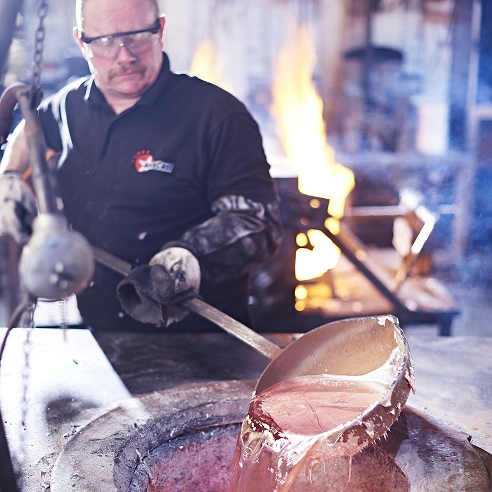
At NovaCast, a large proportion of our castings are produced using Aluminium alloy. The formation of Aluminium Oxide and the presence of non-metallic inclusions, collectively known as dross, is an inherent part of the casting process and one that must be managed to achieve the highest quality castings. For many years, part of the foundryman’s skill has been in the use of fluxes to reduce alloy wastage, manage dross formation and clean the alloy of impurities that would otherwise impact quality.
Understanding Aluminium Alloys
No matter which casting process is used, certain characteristics are inherent in the alloys that are cast, and each create their own set of challenges. Aluminium alloys tend to absorb hydrogen gas and will oxidise readily when molten alloy is exposed to the atmosphere or moisture. The oxidisation process results in a continuous alumina film across the surface. While this remains unmoved, the film protects the molten alloy from further oxidisation.
In a foundry, however, movement is part of the process and this results in cracking of the surface, further oxidisation and a rapid thickening of the surface film. This ever-thickening crust also encapsulates unoxidized Aluminium resulting in a “wet dross” which wastes a considerable amount of alloy. In a typical wet dross, only 20% to 40% is Aluminium Oxide with the rest made up of encapsulated Aluminium. This can result in wastage of 5% to 10% of the total metal melted.
‘Cover’ and ‘Drossing’ fluxes are used to manage these issues by forming a molten barrier “blanket’ on the surface of the alloy to reduce oxidation and hydrogen gas adsorption, and by reducing the thickness of the dross crust. As the surface crust does not thicken as much, these fluxes can reduce the amount of suspended (wasted) liquid metal by 60%-80%.
In addition to oxidisation and gas absorption, Aluminium alloys are susceptible to metallic and non-metallic impurities that are suspended within the molten alloy. Impurities and Aluminium oxides will remain suspended because they are porous and contain some gas adhering to and trapped in the pores. These impurities can be introduced into the melt during charging, treatment or handling operations and must be removed if the quality and consistency of the final casting is to be maintained. Cleaning Fluxes are used to remove non-metallic inclusions from the melt.
Good foundry practice also involves the use of wall cleaning fluxes which help keep crucible and furnace walls above and below the melt line free of oxide build-up. This reduces both alloy wastage and another source of unwanted inclusions.
Environmental Progress
In an increasing environmentally aware world, foundries need to play their part in reducing noxious emissions – both for the good of the planet and their own workforce. Traditionally, fluxes have been a necessary evil; vital in the foundry operation but a source of pollution that needed to be addressed. Flux manufacturers are continually trying to maintain or improve performance while reducing harmful emissions, particularly of fluorides and sulphur oxide. New granular forms of flux are reducing emissions by up to 85% without significant loss of performance as they allow less flux to be used and allow it to work in a different way. It has been found that the morphology of the flux is a very significant contributor to the type and quantity of emissions.
To discuss your requirements, call a member of NovaCast’s team on +44 (0) 1225 707466, send us a message here or email sales@novacast.co.uk.